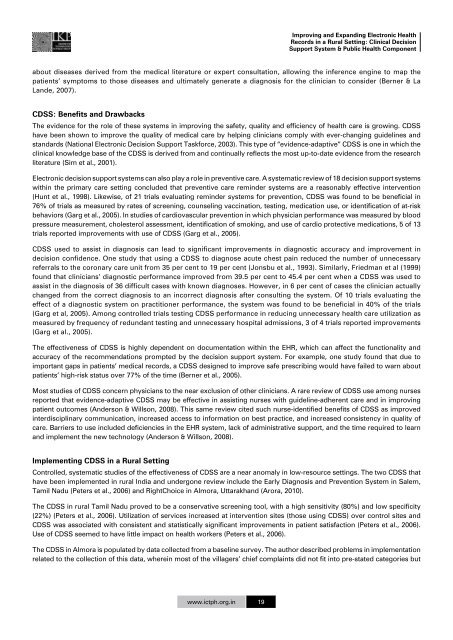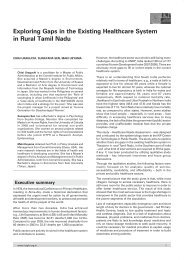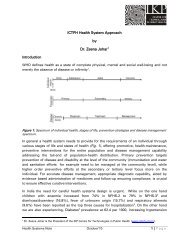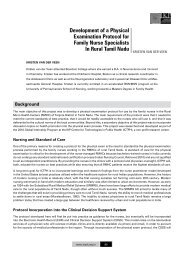Improving and Expanding Electronic Health Records in a Rural Setting
Improving and Expanding Electronic Health Records in a Rural Setting
Improving and Expanding Electronic Health Records in a Rural Setting
You also want an ePaper? Increase the reach of your titles
YUMPU automatically turns print PDFs into web optimized ePapers that Google loves.
<strong>Improv<strong>in</strong>g</strong> <strong>and</strong> Exp<strong>and</strong><strong>in</strong>g <strong>Electronic</strong> <strong>Health</strong><br />
<strong>Records</strong> <strong>in</strong> a <strong>Rural</strong> Sett<strong>in</strong>g: Cl<strong>in</strong>ical Decision<br />
Support System & Public <strong>Health</strong> Component<br />
about diseases derived from the medical literature or expert consultation, allow<strong>in</strong>g the <strong>in</strong>ference eng<strong>in</strong>e to map the<br />
patients’ symptoms to those diseases <strong>and</strong> ultimately generate a diagnosis for the cl<strong>in</strong>ician to consider (Berner & La<br />
L<strong>and</strong>e, 2007).<br />
CDSS: Benefits <strong>and</strong> Drawbacks<br />
The evidence for the role of these systems <strong>in</strong> improv<strong>in</strong>g the safety, quality <strong>and</strong> efficiency of health care is grow<strong>in</strong>g. CDSS<br />
have been shown to improve the quality of medical care by help<strong>in</strong>g cl<strong>in</strong>icians comply with ever-chang<strong>in</strong>g guidel<strong>in</strong>es <strong>and</strong><br />
st<strong>and</strong>ards (National <strong>Electronic</strong> Decision Support Taskforce, 2003). This type of “evidence-adaptive” CDSS is one <strong>in</strong> which the<br />
cl<strong>in</strong>ical knowledge base of the CDSS is derived from <strong>and</strong> cont<strong>in</strong>ually reflects the most up-to-date evidence from the research<br />
literature (Sim et al., 2001).<br />
<strong>Electronic</strong> decision support systems can also play a role <strong>in</strong> preventive care. A systematic review of 18 decision support systems<br />
with<strong>in</strong> the primary care sett<strong>in</strong>g concluded that preventive care rem<strong>in</strong>der systems are a reasonably effective <strong>in</strong>tervention<br />
(Hunt et al., 1998). Likewise, of 21 trials evaluat<strong>in</strong>g rem<strong>in</strong>der systems for prevention, CDSS was found to be beneficial <strong>in</strong><br />
76% of trials as measured by rates of screen<strong>in</strong>g, counsel<strong>in</strong>g vacc<strong>in</strong>ation, test<strong>in</strong>g, medication use, or identification of at-risk<br />
behaviors (Garg et al., 2005). In studies of cardiovascular prevention <strong>in</strong> which physician performance was measured by blood<br />
pressure measurement, cholesterol assessment, identification of smok<strong>in</strong>g, <strong>and</strong> use of cardio protective medications, 5 of 13<br />
trials reported improvements with use of CDSS (Garg et al., 2005).<br />
CDSS used to assist <strong>in</strong> diagnosis can lead to significant improvements <strong>in</strong> diagnostic accuracy <strong>and</strong> improvement <strong>in</strong><br />
decision confidence. One study that us<strong>in</strong>g a CDSS to diagnose acute chest pa<strong>in</strong> reduced the number of unnecessary<br />
referrals to the coronary care unit from 35 per cent to 19 per cent (Jonsbu et al., 1993). Similarly, Friedman et al (1999)<br />
found that cl<strong>in</strong>icians’ diagnostic performance improved from 39.5 per cent to 45.4 per cent when a CDSS was used to<br />
assist <strong>in</strong> the diagnosis of 36 difficult cases with known diagnoses. However, <strong>in</strong> 6 per cent of cases the cl<strong>in</strong>ician actually<br />
changed from the correct diagnosis to an <strong>in</strong>correct diagnosis after consult<strong>in</strong>g the system. Of 10 trials evaluat<strong>in</strong>g the<br />
effect of a diagnostic system on practitioner performance, the system was found to be beneficial <strong>in</strong> 40% of the trials<br />
(Garg et al, 2005). Among controlled trials test<strong>in</strong>g CDSS performance <strong>in</strong> reduc<strong>in</strong>g unnecessary health care utilization as<br />
measured by frequency of redundant test<strong>in</strong>g <strong>and</strong> unnecessary hospital admissions, 3 of 4 trials reported improvements<br />
(Garg et al., 2005).<br />
The effectiveness of CDSS is highly dependent on documentation with<strong>in</strong> the EHR, which can affect the functionality <strong>and</strong><br />
accuracy of the recommendations prompted by the decision support system. For example, one study found that due to<br />
important gaps <strong>in</strong> patients’ medical records, a CDSS designed to improve safe prescrib<strong>in</strong>g would have failed to warn about<br />
patients’ high-risk status over 77% of the time (Berner et al., 2005).<br />
Most studies of CDSS concern physicians to the near exclusion of other cl<strong>in</strong>icians. A rare review of CDSS use among nurses<br />
reported that evidence-adaptive CDSS may be effective <strong>in</strong> assist<strong>in</strong>g nurses with guidel<strong>in</strong>e-adherent care <strong>and</strong> <strong>in</strong> improv<strong>in</strong>g<br />
patient outcomes (Anderson & Willson, 2008). This same review cited such nurse-identified benefits of CDSS as improved<br />
<strong>in</strong>terdiscipl<strong>in</strong>ary communication, <strong>in</strong>creased access to <strong>in</strong>formation on best practice, <strong>and</strong> <strong>in</strong>creased consistency <strong>in</strong> quality of<br />
care. Barriers to use <strong>in</strong>cluded deficiencies <strong>in</strong> the EHR system, lack of adm<strong>in</strong>istrative support, <strong>and</strong> the time required to learn<br />
<strong>and</strong> implement the new technology (Anderson & Willson, 2008).<br />
Implement<strong>in</strong>g CDSS <strong>in</strong> a <strong>Rural</strong> Sett<strong>in</strong>g<br />
Controlled, systematic studies of the effectiveness of CDSS are a near anomaly <strong>in</strong> low-resource sett<strong>in</strong>gs. The two CDSS that<br />
have been implemented <strong>in</strong> rural India <strong>and</strong> undergone review <strong>in</strong>clude the Early Diagnosis <strong>and</strong> Prevention System <strong>in</strong> Salem,<br />
Tamil Nadu (Peters et al., 2006) <strong>and</strong> RightChoice <strong>in</strong> Almora, Uttarakh<strong>and</strong> (Arora, 2010).<br />
The CDSS <strong>in</strong> rural Tamil Nadu proved to be a conservative screen<strong>in</strong>g tool, with a high sensitivity (80%) <strong>and</strong> low specificity<br />
(22%) (Peters et al., 2006). Utilization of services <strong>in</strong>creased at <strong>in</strong>tervention sites (those us<strong>in</strong>g CDSS) over control sites <strong>and</strong><br />
CDSS was associated with consistent <strong>and</strong> statistically significant improvements <strong>in</strong> patient satisfaction (Peters et al., 2006).<br />
Use of CDSS seemed to have little impact on health workers (Peters et al., 2006).<br />
The CDSS <strong>in</strong> Almora is populated by data collected from a basel<strong>in</strong>e survey. The author described problems <strong>in</strong> implementation<br />
related to the collection of this data, where<strong>in</strong> most of the villagers’ chief compla<strong>in</strong>ts did not fit <strong>in</strong>to pre-stated categories but<br />
www.ictph.org.<strong>in</strong> 19









